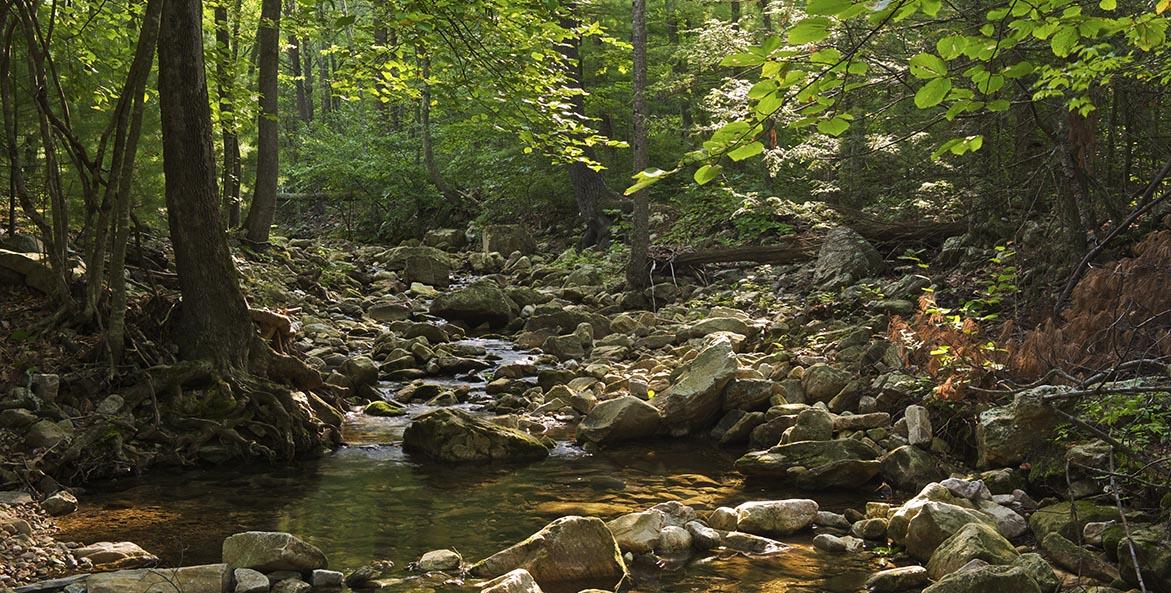Pledge to Protect Our Trees!
Sign Our Pledge
Why Are Trees Important to Our Waterways?
From capturing and filtering out pollution before it enters our waterways to alleviating flooding by stabilizing the soil, trees provide countless health, economic, and environmental benefits.
Despite their value, they continue to disappear at an alarming rate, and efforts to restore them are lagging. At a time when states, counties, and municipalities are struggling to meet water quality goals, planting trees remains one of the most successful and cost-effective solutions to reducing polluted runoff and cleaning local waterways.
In particular, riparian buffers—trees and shrubs planted along streams—provide outstanding benefits, reducing nitrogen, phosphorus, and sediment pollution in both rural and urban landscapes. Research suggests that riparian buffers remove from 19 to 65 percent of the nitrogen pollution; 30 to 45 percent of the phosphorus pollution; and 40 to 60 percent of the sediment that would otherwise enter adjacent streams. Beyond their filtering prowess, tree canopies shade and cool water, helping to prevent wide fluctuations in temperatures that can stress fish and other aquatic life, and also help stabilize stream banks and reduce erosion. Furthermore, streamside forests sequester carbon and can provide habitat for wildlife, including pollinators, and act as wildlife corridors, providing cover and food sources.
Why Are Trees Disappearing from the Watershed?
Unfortunately, the watershed loses more open land and greenspace to development each year. Pennsylvania, Maryland, and Virginia collectively developed an average of 33,000 acres of open land per year between 2009 and 2019. Much of the loss—roughly 14,000 acres per year—occurs on farmland, though forests are also impacted. Existing urban and community areas are losing tree cover at a rate equivalent to approximately 36 million trees annually across the United States. Washington, D.C. was among the jurisdictions with the greatest decline in percentage of urban tree cover each year between 2009 and 2014.
How Do Trees Improve Our Lives?
Trees can thrive in urban, suburban, and rural locations, providing unique benefits to each setting. In urban locales, parking lots, roads, and buildings absorb and trap the sun's heat, creating what's referred to as an urban heat island effect. Planting trees can significantly cool neighborhoods. Properly placing trees around buildings can reduce air conditioning needs by 30 percent and can save 20-50 percent in energy used for heating. Trees also filter airborne pollutants, reducing conditions that cause asthma which are prevalent in urban communities. In suburban areas, trees have a positive impact on the salability of homes, with studies finding they can increase property values as much as 20 percent. And in rural locations, one acre of forest can produce between $12,000-$77,000 in environmental benefits each year.
In addition, research has found that some of the nation's hottest neighborhoods were once redlined under racially discriminatory home lending practices, and often remain home to communities of color and those with lower incomes. Environmental justice efforts, such as the Greening Southside Richmond Project, are beginning to bring the cooling and health benefits of green spaces to many of these neighborhoods.
To save the Bay, forests need to flourish throughout the watershed and greenways in our neighborhoods. In addition to planting thousands of trees in critical areas, CBF will continue fighting for strong and sustainable forest protections that will allow trees to continue their water filtering prowess and many other benefits, for generations to come.
See our blog for stories about the importance of trees in the Chesapeake Bay watershed.



